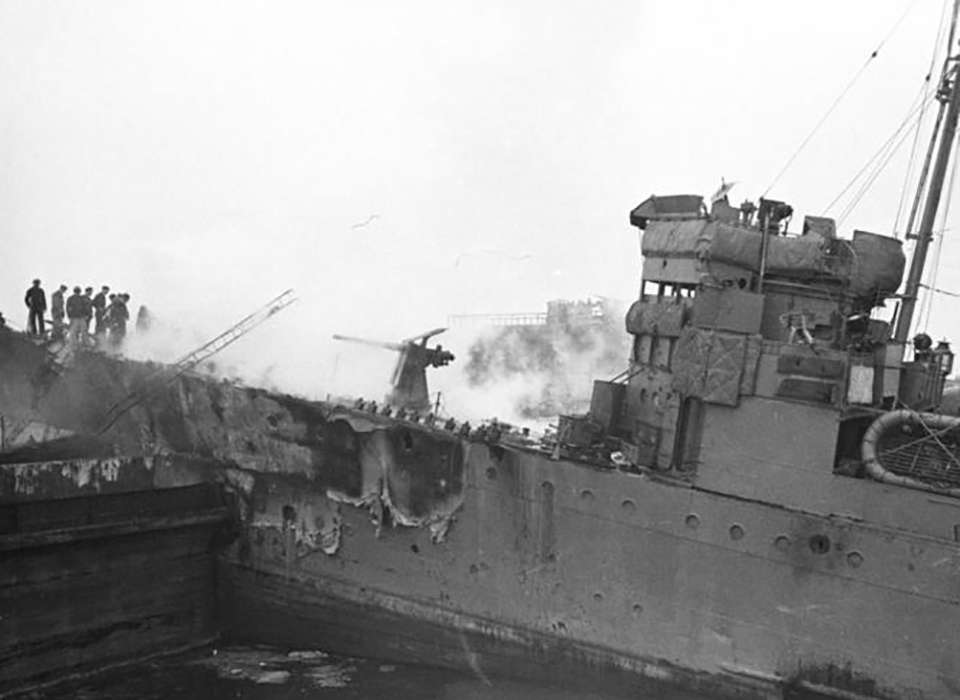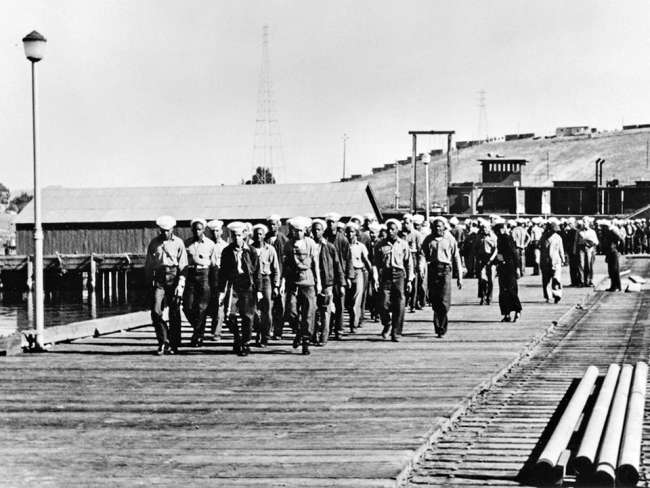Top Image: HMS Campbeltown lodged on the drydock in St. Nazaire. Bundesarchiv, Bild 101II-MW-3722-03 / Kramer / CC-BY-SA 3.0.
Winston Churchill faced a bleak winter of 1942 that promised continued air raids, setbacks on land, and struggles on the home front exacerbated by German U-Boat and surface fleets strangling supply routes to his beloved island.
Although Churchill believed that the involvement of the United States in the war had tilted the odds of victory toward the Allies, he knew that Britain needed positive engagements to maintain morale and buy time for the United States to spool up to a war footing.
By January 1942, the German U-Boat fleet had grown to nearly two hundred vessels with roughly half operational at any moment. To gain dominance over the Atlantic shipping lanes that supplied Britain and Russia, Kriegsmarine Admiral and former WWI U-Boat commander, Karl Dönitz needed either more submarines or stronger engagement from the German surface fleet, particularly the newly operational battleship Tirpitz.
Tirpitz was slightly larger than its recently sunk sister ship Bismarck and had a top speed of 30 knots, a range of 8,000 nautical miles, and four dual sets of 38cm guns. She bristled with dozens of 15 cm and 10.5 cm guns as well as anti-aircraft guns and torpedo tubes. At over 50,000 tons, Tirpitz was heavily armored and could outgun or outrun any other warship.
For Britain, satisfaction from sinking Bismarck in May 1941 was tempered by the fact that, before she succumbed, Bismarck had sunk the vaunted HMS Hood in 10 short minutes and severely damaged the new HMS Prince of Wales. The hunt for Bismarck occupied most of the fleet, leaving Atlantic supply convoys to the mercy of German U-Boats. So Churchill and his Admiralty were obsessed by the Tirpitz lurking in Norway’s fjords. As he put it, “The whole strategy of the war turns at this period on this ship.”
Churchill was a master tactician and involved himself in all manner of wartime decisions. In October 1941, he appointed trusted friend Lord Louis Mountbatten, nephew of the King and a war hero, to lead the Combined Services Command which was responsible for attacks designed to harass and cripple Axis targets. Vice Admiral Mountbatten’s penchant for bold strokes matched perfectly with Churchill and he led the planning for what became Operation Chariot.
At Churchill’s direction, the strategy was to target the last safe haven for the Tirpitz, and by doing so, raise the stakes if she were ever to engage in the North Atlantic. The operation would achieve its objective in stunning fashion but at a high cost. Of the 611 Royal Navy and Commandos taking part in the raid, a staggering 169 raiders perished and 265 were captured. Mission participants garnered 89 medals and more Victoria Crosses than any other WWII operation. Operation Chariot was perhaps the most heroic action in the storied history of the Combined Services Command.
The operation was approved on March 3, 1942, with an execution date just three weeks later. Its primary objective was to deny the German surface fleet access to the only dry dock on Europe’s western coast that could accommodate a behemoth like the Tirpitz. Located in the southern French port of St. Nazaire and built in 1932 to service the SS Normandie, the largest cruise ship of its era, the St. Nazaire dry dock was state of the art. It measured over 300 meters by 50 meters with a 16-meter depth, and featured a pair of massive gates at each end. Water levels were controlled by large pump houses.Without access to the St. Nazaire dry dock, the Germans were unlikely to risk their last Bismarck-class battleship in combat since she would be vulnerable in open waters for far longer if damaged and forced to limp back to Norway or Germany for repair.
St. Nazaire, with a civilian population of 50,000, also served as a primary base of operations for the German U-Boat fleet. Given its strategic importance, the Germans maintained a significant security presence including 6,000 troops assigned to protective duties. Most of the boat crews and mechanics were also trained to handle weapons if necessary, although defensive plans called for the highly trained U-Boat crews to be evacuated to safety when under attack.
Fortified submarine pens featured a 3.5-meter-thick steel reinforced concrete roof to protect from air attack. Extensive anti-aircraft gun emplacements, plus the French homes and establishments in close proximity to the naval facilities, rendered the port difficult to attack by air.
The final plan for Operation Chariot, approved after an intensive three weeks, called for moving dozens of commando teams into position for a stealthy amphibious assault to destroy the dry dock and other targets in the harbor. Requiring nearly 20 vessels, it was an audacious plan that demanded expert seamanship, nerves of steel and extraordinary courage. Mountbatten tapped Commander Robert Ryder to lead the naval tasks and charged Lt. Commander Charles Newman with leading the commando assault.
German outer defenses included French fishing trawlers at the mouth of the Loire Estuary that often served as picket lines, with German sailors occasionally disguised among the crew serving as lookouts. The Estuary offered natural defenses, given that its shallow depth and muddy shoals posed challenges even for a seasoned navigator. A deeper channel had been dredged to ease passage but this approach, adjacent to the northern shoreline, was peppered with gun batteries and powerful searchlights. The planners were determined to avoid this more dangerous route, known as the Charpentier Channel, and preferred a course to the south over the shallow flats and leading directly to their target. Tidal depth research favored a night assault, so the British flotilla would proceed under cover of darkness and attack shortly after midnight.
Critical to achieving the objective of disabling the gates that formed the entrance to the dry dock would be the HMS Campbeltown, an obsolete four-stack WWI destroyer acquired by Britain from the United States as part of the Lend Lease program. The Campbeltown would be stripped down, camouflaged, and commanded by Lt. Commander Stephen Beattie, a figure of unflinching courage. Campbelltown would carry multiple commando teams, ram the dry dock gates and disable them with a massive explosive.
The demolition design fell to Lt. Nigel Tibbets, a 28-year-old explosives expert. His concept called for two dozen 180 kg depth charges to be cemented together and disguised in the bow of the Campbeltown. The combined five tons of explosives were then armed with three “pencil” fuses which would spark eight to 10 hours after they were activated.
Campbeltown was the size of a German Möwe-Class torpedo boat and changes to its superstructure, like eliminating two of her four stack and angling the remaining two gave her a German silhouette. They equipped her with Oerlikon guns but removed her main gun and replaced it with a lighter 12 pounder. The shipwrights added additional armor plating around the deck and the bridge, while stripping all other extraneous equipment to reduce her draft.
While the Campbeltown was getting its face lift, the 600 members of the attack teams engaged in grueling specialized training and rehearsals to destroy as many of their objectives as possible. The flotilla left Falmouth on the afternoon of March 26 on a southerly course.
The journey was uneventful until they encountered a German U-Boat 209 km west of St. Nazaire. One of the escort destroyers gave chase but failed to sink it. In a stroke of good fortune, the U-Boat was able to radio an alert on the convoy, but its Captain sent an incorrect heading and reinforced a British ruse that the convoy was headed further South toward Gibraltar or Africa or that it appeared to be a mine laying operation.
The flotilla next encountered French fishing trawlers, but concluded after stopping and searching them that they were not functioning as German lookouts. But to be safe, the fishing crews were transferred to an escort destroyer and the trawlers were scuttled. After midnight on March 28, the flotilla left its two escort destroyers at sea and, with Campbeltown and three motor launches in the lead all flying Nazi flags, commenced the six-kilometer run through the mud flats and into Nazaire. The Campbelltown scraped bottom twice but crawled forward. Between the Campbeltown’s resemblance to a German torpedo boat and its German Kriegsmarine flag, they managed to slip by some of the outer lookouts without serious challenge, although occasional tracer fire streaked over their position.
German defenses were on full alert. The RAF air raid on the town, conducted earlier in the evening and intended as a diversion, was thwarted by cloud cover and had instead raised German suspicions that an attack was in the works.
As the flotilla progressed, German suspicions increased, and the vessels were challenged and messaged. Equipped with secret codes acquired through an earlier raid in Norway, the British responded with an authentic code indicating that they were friendly vessels coming in for repairs and that created brief confusion among the German defenders. But the ruse was fast coming undone. German spotters illuminated their searchlights and commenced firing in earnest. The British immediately returned fire, Beattie ordered the lowering of the German flag and replaced it with the white British battle standard. The entire flotilla followed suit and the Commandos of Operation Chariot went into battle flying the King’s colors.
The trailing boats of the kilometer-long convoy were subjected to withering gunfire from the shoreline defenses. Mahogany boats laden with fuel proved a fatal mismatch but they pushed on, fought back, and continued toward their objectives despite horrific losses.
Even with the enhanced armor plating protecting the bridge of the Campbeltown, the incoming fire was so intense that Beattie lost two helmsmen. Tibbets, who had already initiated the three “pencil” fuses on the bombs as they entered the estuary, was on the bridge and took the helm as Beattie issued final navigational commands, aided in part by the added visibility afforded by the German searchlights. They came off the mud flats, went to flank speed, tore through an anti-sub net, and braced for impact.
At 0134 the Campbeltown slammed into the top of the massive dry dock caisson. Its 19-knot speed enabled nine meters of her bow to continue to lurch forward, coming to rest at the dead center of the entrance gates with its forecastle hanging above. That left the four and a half tons of hidden explosives that she carried in perfect position to produce maximum damage. As the ship came to an abrupt halt and the commandos disembarked for their ground attack, Beattie blithely announced, “Well here we are, four minutes late.”
Read more in The British Raid on St. Nazaire: Part II.
Meet the Authors
Thurgood Marshall, Jr. has served in each branch of the federal government, including as the Assistant to the President and White House Cabinet Secretary to President Clinton and, prior to that, as Director of Legislative Affairs and Deputy Counsel to Vice President Gore. Mr. Marshall also held a position on the Senate leadership staff, served as counsel to the Senate Judiciary Committee, the Committee on Commerce, Science & Transportation, the Governmental Affairs Committee, and was appointed by President George W. Bush to membership on the US Postal Service board of governors. Mr. Marshall was also a partner at the law firm of Morgan Lewis where he advised clients engaged in public policy. He began his career as a law clerk for US District Judge Barrington D. Parker in the US District Court for DC. Mr. Marshall also serves on the boards of two publicly traded companies and The Third Way. He is a former board member of the Ford Foundation and the National Women’s Law Center, among others. Mr. Marshall is a nationally recognized attorney and has received several awards for his public service. He is a graduate of the University of Virginia School of Law.
Peter Goelz is senior vice president at O’Neill and Associates and offers decades of experience in national crisis communications and federal relations, with a specialty in aviation and transportation. He is regularly sought-after by national media as a commentator on aviation safety matters, appearing frequently on CNN, CBS Evening News, FOX News, MSNBC, and others. Most recently, Mr. Goelz worked for an international public relations firm where his clients included major airlines, aviation maintenance companies and leading transportation safety and security firms. Previously, Mr. Goelz served as managing director of the National Transportation Safety Board. He is widely hailed as one of the country’s most experienced coordinators in disaster situations.
Cite this article:
MLA Citation:
APA Citation:
Chicago Style Citation:








![Max Fuchs, New York City cantor, sings as Rabbi Sydney [sic] Lefkowitz, Richmond, VA, conducts the first Jewish services from Germany.](/sites/default/files/styles/max_650x650/public/2025-10/image1.jpg)






